|
|
|
The Coast to Coast is a classic.
The 239-kilometre (149-mile) race from the west coast of the South Island of New Zealand, across the Southern Alps, to the east coast of the South Island has been held annually since 1983. As a Finnish participant in the February 2000 race noted, “The Coast to Coast is one of the biggest races around the world. Everybody is talking about the Coast to Coast.”
I had thought about doing the Coast to Coast since 1990, but other commitments (such as mountaineering expeditions) kept on getting in the way. I didn’t achieve my initial aim of doing the Coast to Coast before I turned 50, but year in and year out the idea simmered away. I frequently picked up and paged through Bob McKerrow and John Woods’ book, Coast to Coast: The Great New Zealand Race.
While we were climbing Aconcagua in late 1994, Annette Morris – one of my climbing companions (as well as being a superb triathlete) – and I discussed the possibility of doing the Coast to Coast in 1997, but nothing came of the idea. In late October 1998, however, I was in England on sabbatical leave, and met Annette in the Lake District. At the top of a small peak, Grisedale Pike, we decided to do the Coast to Coast in February 2000 – not as a team, but as individuals.
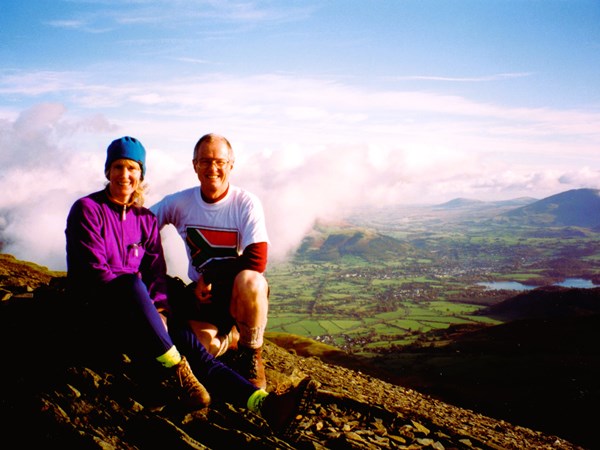
While we were on the summit of Grisedale Pike in October 1998, Annette Morris and I decided to do the 2000 Coast to Coast race.
The idea was cemented in place less than two days later when an email from my son, Evan, suggested that he and I should run a marathon in mid-1999. I said yes immediately: achieving marathon-level fitness by the middle of the year would be an extremely sensible intermediate goal for my Coast to Coast training programme.
TRAINING
On 1 February 1999 I started my gradual build-up towards doing a marathon by running a total of fifty kilometres a week for two weeks, then sixty kilometres a week during the next fortnight, and so on. Evan and I had initially intended to run the Rotorua marathon at the beginning of May, but for a variety of reasons we changed our plans and decided to do the Christchurch marathon instead. It proved to be a fortuitous decision: torrential early morning rain and consequent flooding meant that for the first time in its history, the Rotorua marathon was cancelled. By way of contrast, the Christchurch marathon was held on Sunday morning, 6 June, in perfect conditions.
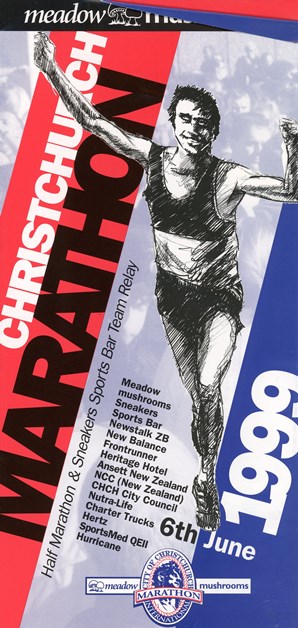 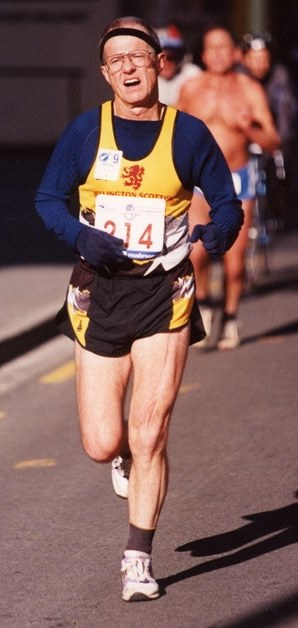
The first part of my Coast to Coast training programme: running the 1999 Christchurch marathon.
It was Evan’s first marathon, and he ran a cracker of a race. He had put an estimated time of three hours on his application form; he finished in 2:53:20 – which was tactfully (?) 17 seconds short of beating my best-ever time. I, too, ran a faster race than I had initially anticipated. I had put down 3 hours and 45 minutes as my estimated time, but was secretly hoping to finish in less than three-and-a-half hours. The flat course and the cold, still weather were tailor-made for me, and I ran the 42.2 kms in 3 hours, 12 minutes, and 6 seconds. In doing so, I came second in my age group (viz., 50 to 59-year-old males). In doing so, I also injured my right knee.
The rest of June and July saw me make frequent visits to a local sports medicine clinic and physiotherapist. However, at the beginning of July I had some good news. My application to do the Coast to Coast was successful.
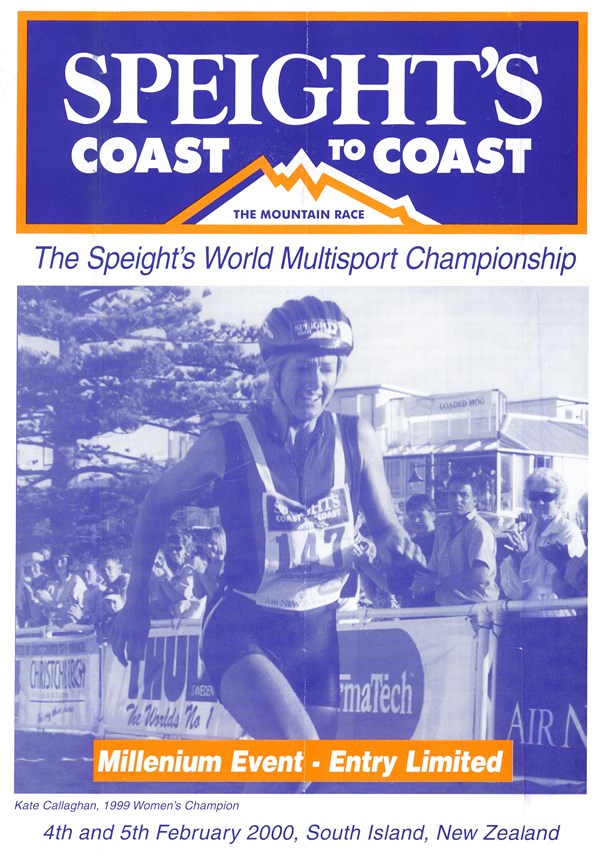
The February 2000 Coast to Coast entry form.
In August, I switched my attention to two new sports. I bought a road bike and began the painful process of getting used to its narrow saddle, and I started a series of seven kayaking lessons. I was taught kayaking by a policeman, Tony Jennings. Every year, Tony ran a special course for budding Coast to Coasters, and one of the beneficial side-effects of enrolling in Tony’s kayaking course was getting to know three other people, who – like me – were hoping to do the race for the first time. Even though I was older than Rachel Beattie (24) and Jason Page (26) combined, as well as being considerably older than the oldest of the three, Angus Wood (33), I enjoyed their company immensely and really appreciated the help they gave me during the course. On Saturday, 9 October, we spent four-and-a-quarter hours kayaking down the Rangitikei river and – by doing so successfully – qualified for our Grade 2 kayaking certificates.
On 7 December 1999, I flew to the United States to attend a conference at the University of Notre Dame (in South Bend, Indiana). Unfortunately, I caught a bad dose of flu four days later, had a dreadful flight to San Francisco the following day, and then had three days visiting friends, Peggy and Austin Wall, which I spent largely in bed. I arrived back in Wellington on 18 December and saw my GP, Ken Greer, a few days later. He thought my chances of competing in the Coast to Coast were minimal, but he put me on a Becotide asthma inhaler to help get rid of the fluid in my lungs, and he said I could resume training if and when I wanted to. I almost pulled out of the race then, but – after mulling over the matter – I decided that as I had already paid to do a guided kayaking trip down the Waimakariri river on 3 January 2000, I would see how that trip went and would cross both the Waimakariri and my own personal Coast to Coast Rubicon at that stage.
The one-day trip guided by Bruce Leslie from the Christchurch company, Canoe and Outdoor World (COW for short) was, indeed, a turning point for me. On an unseasonably cold day, two other middle-aged, first-time Coast to Coasters – Jerry Rickman (53) and David Southall (42), both from Hamilton – and I successfully made our way down the Waimakariri from the Mt White bridge to Woodstock, the first 55 kms or so of the 67 km Coast to Coast kayaking course. It took us 4 hours and 35 minutes. I came out twice, ditto Dave, and Jerry just once. But when we had finished, I was enormously encouraged: for the first time in four weeks, I thought I could possibly – just possibly – do the Coast to Coast. The three of us were on a high, and I invited Jerry and David home to where I was staying in Merivale to meet my wife, Heather, so that she could at least see that I wasn’t the only mad bugger in the world ...
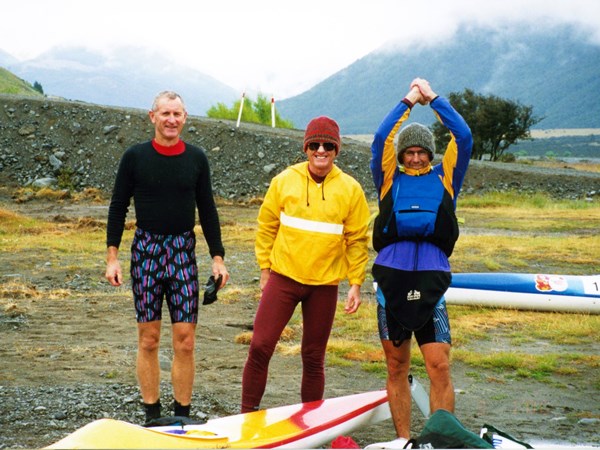
Left to right: Jerry Rickman, Nigel Roberts, and David Southall at Woodstock on 3 January 2000 after kayaking down 55 kilometres of the Waimakariri river.
Heather left to work in Vietnam on 10 January, and on the same day I began a final three weeks of intensive training for the Coast to Coast. I’d come home from work, go out for a hard 16 km bike ride (to Johnsonville and back), shove my bike in the lounge, and then set off on a reasonably tough 55-minute run (on a course Steve Merrifield and I had “pioneered” when he, Tania, and Luke visited New Zealand in August 1999). On other evenings, I’d do three hours kayaking on Wellington harbour before starting to cook my evening meal sometime after 9:00 pm. During weekends, I went out for rides with Angus Wood (who taught me the principles of bunch riding) and Rachel Beattie and Craig Duncan (who helped me put them into practice – in a bunch of three). On Friday, 21 January, I flew to Christchurch for the weekend, hoping to do a guided run up the Deception river, across Goat Pass, and down the Mingha river with Chris Cox. We drove over the main divide and all the way to the Deception river footbridge in the Otira valley, but appalling weather – which included thunder, lightning, and torrential rain at Arthur's Pass – meant it was impossible to do the run. Instead, my weekend’s exercise included a hard hour-and-a-half bike ride (on Donal Hockey’s old mountain bike) along the Old West Coast Road and a hot, two-hour 20 km or so run from Sumner to the Godley Head gun emplacements and back. I returned to Wellington, and – after a final ride and run on Monday, 31 January, and an hour-long kayaking session on Tuesday afternoon, 1 February – I knew that from a physical standpoint, I was as ready as I ever would be to do the 2000 Coast to Coast.
Other preparations were finalised too. Annette Morris and a friend of hers, Peter Skelton, arrived in Auckland on 17 January and made their way down to Wellington. Annette and I arranged to meet at a restaurant on Tuesday evening, 25 January, for a working dinner in order to finalise our plans for the Coast to Coast. Pete was going to be Annette’s assistant during the transition stages of the race. Heather and Evan had originally agreed to be my assistants for the race, but Heather’s departure for Vietnam meant I had to find someone else. Luckily, a University- and climbing-friend, Kate Hunter, jumped at the chance to experience the Coast to Coast as an assistant, and the five of us – Annette, Pete, Kate, Evan and I – had an enjoyable and highly useful dinner. Our first group photo was taken that evening in the Café Istanbul.
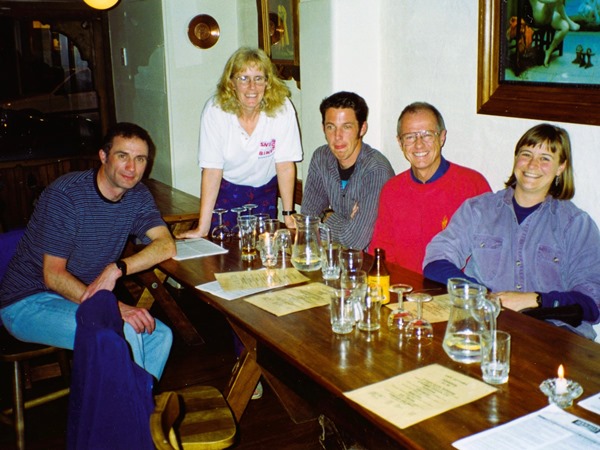
Left to right: Peter Skelton, Annette Morris, Evan Roberts, Nigel Roberts, and Kate Hunter during our planning meeting / dinner at the Café Istanbul on 25 January 2000.
GETTING THERE
Annette and Pete left for the South Island on Thursday, 27 January 2000, after we’d arranged to meet them in Greymouth a week later. At 8:30 am on Wednesday, 2 February, Kate, Evan, and I arrived at the ferry terminal in Wellington in our yellow Toyota Corolla with my purple Penguin sea-kayak on top and my silver Avanti Monza bicycle on the tow-bar bike carrier. In the words of a sign on one of the other Coast to Coast vehicles catching that morning’s ferry, it wasn’t hard to guess where we were going.
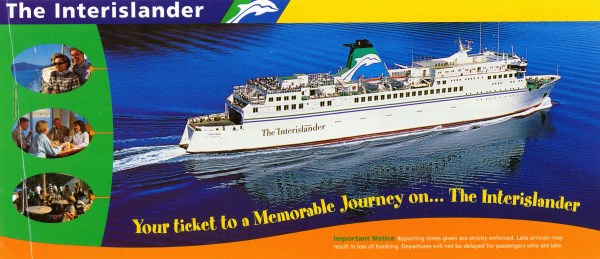
Above: Our "ticket to a memorable journey". Below: Car, kayak, and bike – as well as Kate, Nigel, and Evan – at the ferry terminal in Wellington on Wednesday morning, 2 February 2000.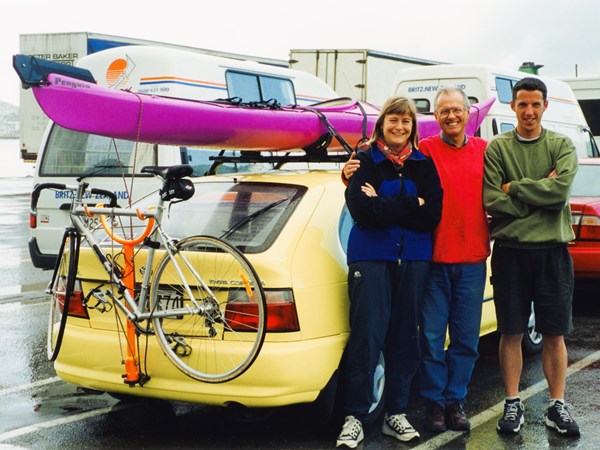
We arrived in Picton at 12:30 pm and drove down State Highway 1 to Christchurch, which we reached shortly before 7:00 pm. Close friends, Burn and Margaret Hockey, had very kindly invited us to stay with them. I had stayed with Burn and Margaret ten days earlier (when I went to Christchurch for the abortive trial run), so it wasn’t their first involvement with my attempt to do the Coast to Coast, and it wasn’t their last either. On Thursday morning, 3 February, Kate, Evan, and I set out for the West Coast. We deliberately went the long way to the West Coast (via Christchurch, instead of going directly from Picton though the Buller gorge) to enable Kate and Evan to see each of the transition points before the race. Our first stop was the Gorge bridge over the Waimakariri river – the spot where the kayaking leg of the race ends. We then proceeded via a very pleasant coffee at a cafe in Springfield to the Mt White bridge, which is where the kayaking section starts. We didn’t stop at Klondyke Corner (where the mountain run ends and where most of the two-day Coast to Coast competitors and their assistants camp overnight before the start of the second day of the race), but we did stop and had a picnic lunch at the confluence of the Otira and Deception rivers, where the first cycle leg of the race ends and the mountain run begins. We then headed down to Kumara beach – the starting point of the race – to pay homage to the Tasman Sea. Just as we were leaving the beach, a TV3 car drew up and asked us if we could leave our car overlooking the beach for a while; it would make an appropriate backdrop for them. We did so – and the car, kayak, and bike duly appeared on the news that evening.
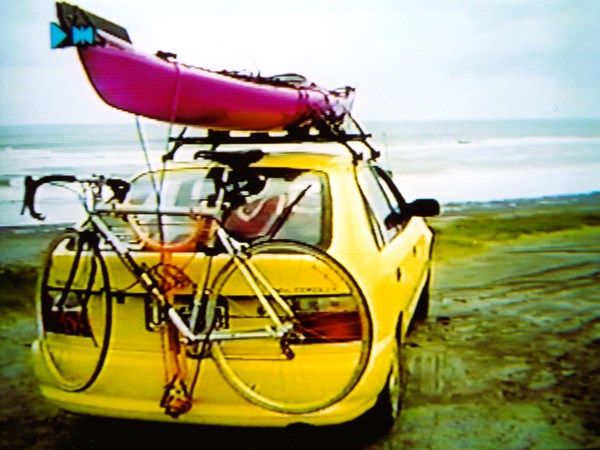
Above: As seen on TV – our car overlooking Kumara beach. Below: As seen on TV – Kees and Anton Wesselink's van at the Kumara race-course.
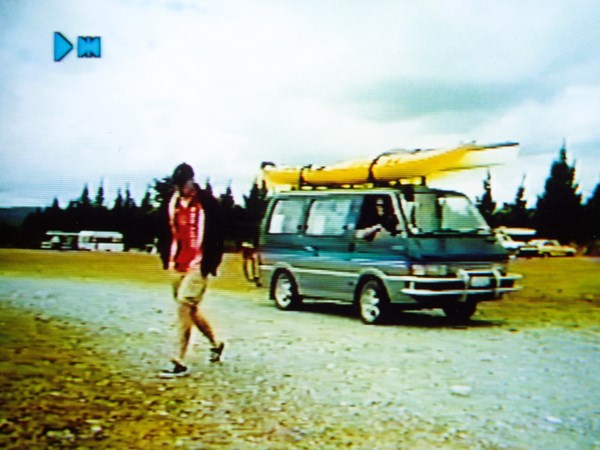
We then drove north to Greymouth, where we checked into the Ashley Hotel. Pete had seen us go past while he was out for a ride, so he turned round and pedalled furiously back to the hotel. A short while later, Kate and Evan briefly went off to town in our Toyota, while Annette, Pete, and I drove back to Kumara in their rented Subaru so that Annette and I could go to the racecourse and register for the Coast to Coast. We wandered round catching up with old friends – quickly bumping, for example, into both Dave Southall (and his wife Wendy) and Jerry Rickman (and his wife Julie), and meeting another competitor who was also planning to use a sea-kayak on the Waimakariri, 61-year-old Kees Wesselink and his family from Hamilton. Kees’ son, Anton, was going to do the one-day race. Their van – topped as it was by two kayaks – also had a small starring role on that evening’s TV3 news.
Kate and I put decals featuring my race number (viz., 306) on my cycling and kayaking helmets, on my bike, and on my kayak, and we then made our way to the Kumara Memorial Hall (where we were rejoined by Evan after a run and a shower), and joined the first (i.e., the 5:30 pm) sitting of the pre-race dinner.
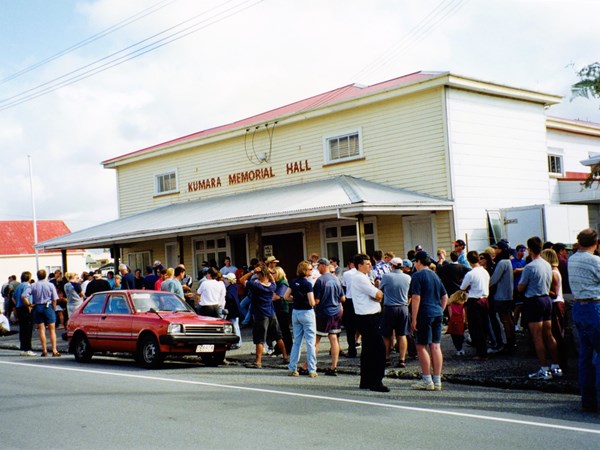
Coast to Coast competitors and assistants outside the Kumara Memorial Hall.
With an hour-and-a-half to kill after dinner, Kate, Evan, and I drove back to Kumara beach and went for a walk to wear off the effects of too much food. On the beach I picked up a lovely little oval white stone; I was determined to find an equivalent souvenir on the South Island’s Pacific Coast two days later.
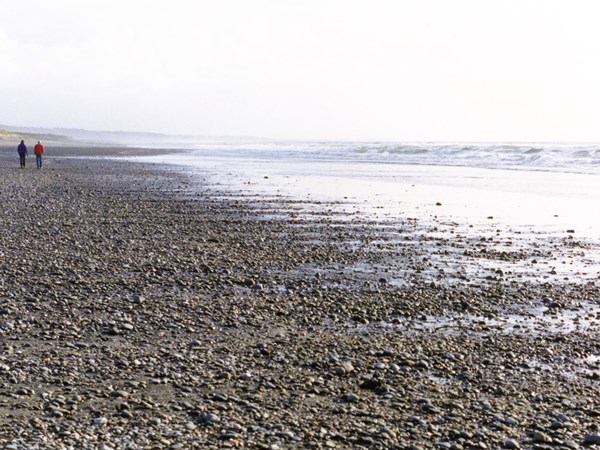
Above: Walking on Kumara beach on Thursday evening, 3
February 2000. Below: The "lovely little oval white stone" that I picked up on the beach.
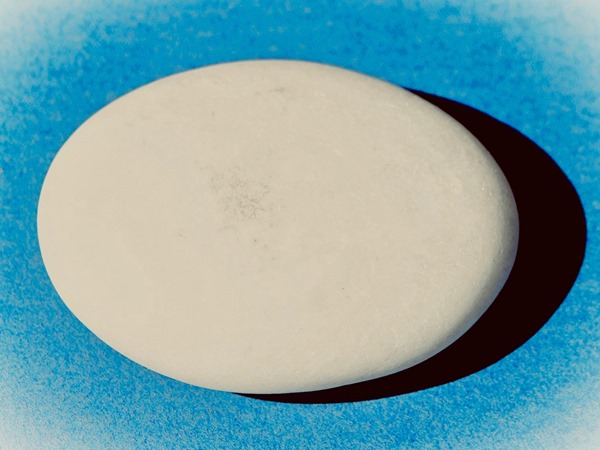
The Kumara hall was packed at 8:00 pm, so – along with hundreds of others – we had to listen to an outside broadcast of Robin Judkins’ safety briefing, which was memorable only for being unmemorable. If we had been inside the hall and seen him in his tutu and wig, the talk might have had more impact. As it was, we were happy to return to Greymouth and were in bed by about 10:00 pm.
DAY ONE OF THE RACE
I set my alarm for 4:25 am on Friday, 4 February, but – after a surprisingly good sleep – I was awake a few minutes earlier and got up and had my standard breakfast (muesli, fruit and yoghurt, two slices of toast, and a cup of coffee): it was not the time for a new diet. We hit the road an hour later, and Kate and Evan dropped me at Kumara Junction – at the roundabout where State Highways 6 and 73 meet. Kate and Evan turned left (i.e., east) in order to drop my bike off at the bike racks and then head on up to the first transition area near the Deception river, while I turned west. In the pre-dawn darkness, I walked down to the start-line on Kumara beach.
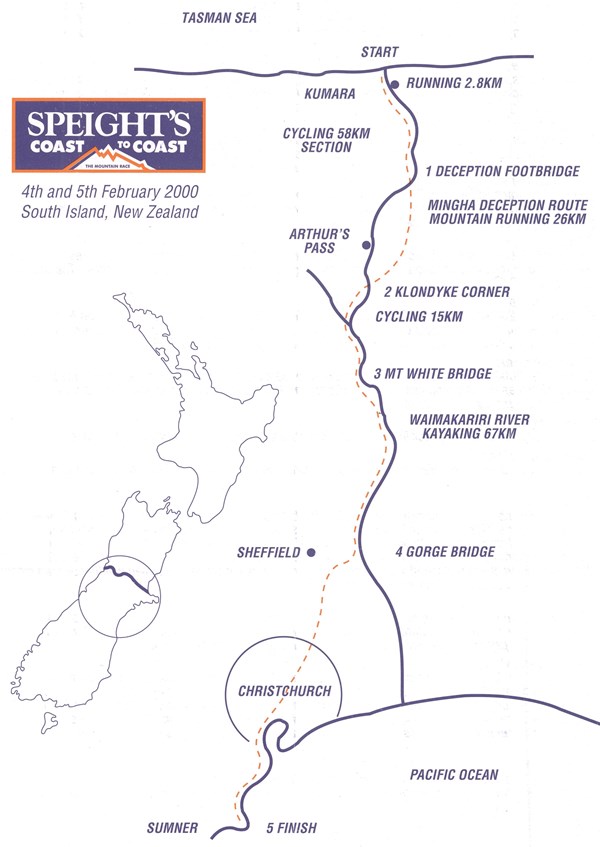
A map of the February 2000 Coast to Coast course.
I was early – but, thankfully, that gave me plenty of time for a pre-race trip to the Portaloos. I met Dave Southall and Jerry Rickman, as well as Rachel Beattie and Craig Duncan. Although there were nearly 500 people doing the two-day race either, like myself, as individuals or as part of a team, it was surprisingly easy to find my friends in the grey, early morning light.
• Kumara beach to the Deception river
Jerry Rickman and I had decided we would do the first section of the race together, and when Robin Judkins started the Coast to Coast at 7:00 am, we ran the 2.8 kms from the beach to the bike stands very slowly (partly because we wanted to hang back deliberately and thus avoid the large, fast bunches of bicycles, and partly because one of Jerry’s legs was giving him a great deal of trouble).
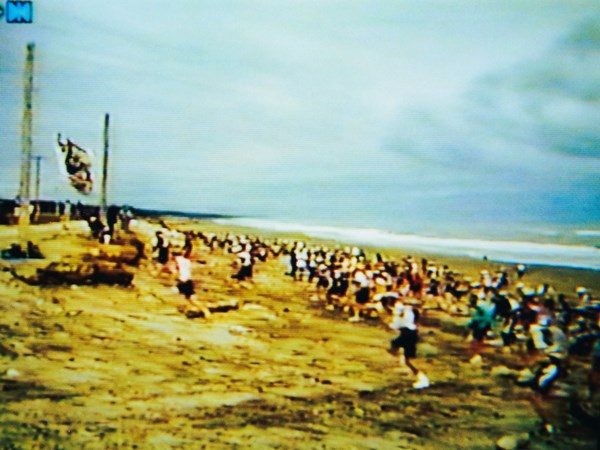
Above and below: As seen on TV – stills from TV3's coverage of the start of the February 2000 two-day Coast to Coast race. Rachel Beattie is the person in the lower centre of the lower picture.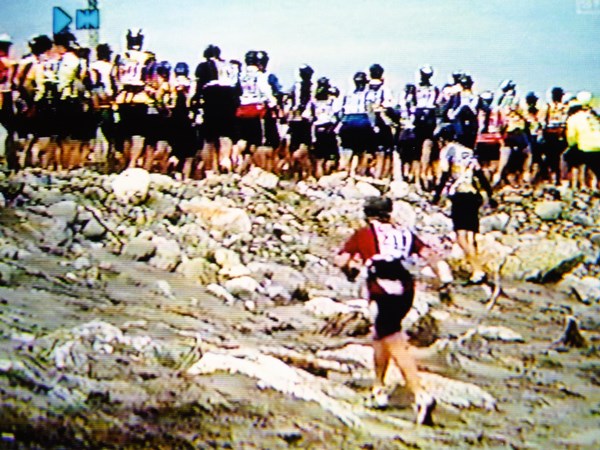
As a result of our deliberately slow start, both Jerry and I had a lot of energy when we reached our bikes, and we were both in a good position to appreciate the first ride – so much so that I had the most enjoyable and most exhilarating ride of my life. The 58 kms from Kumara Junction to the Deception river transition area has more uphill than downhill (after all, the road heads inland towards the main divide), but for the most part the route is across coastal flatlands. What is more, during the race the road is closed from Kumara Junction until Jackson’s, which means that cyclists can quite safely occupy the entire left-hand side of the road.
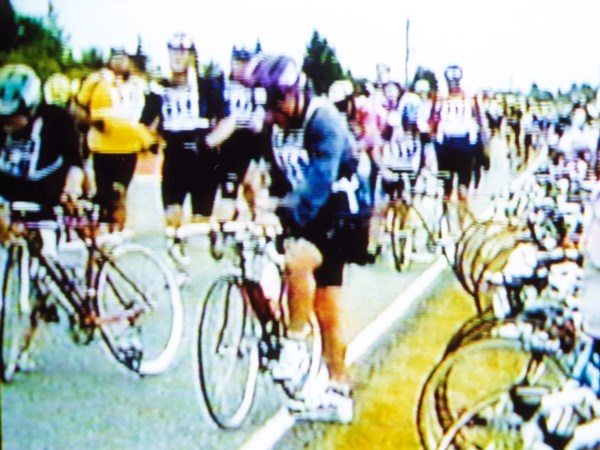
Above: A still from TV3's coverage of the first day of the February 2000 two-day Coast to Coast race showing a part of the start of the first cycling section of the race. Below: A still from TV3's coverage of the first day of the February 2000 two-day Coast to Coast race showing a portion of a peloton in the first cycling section of the race.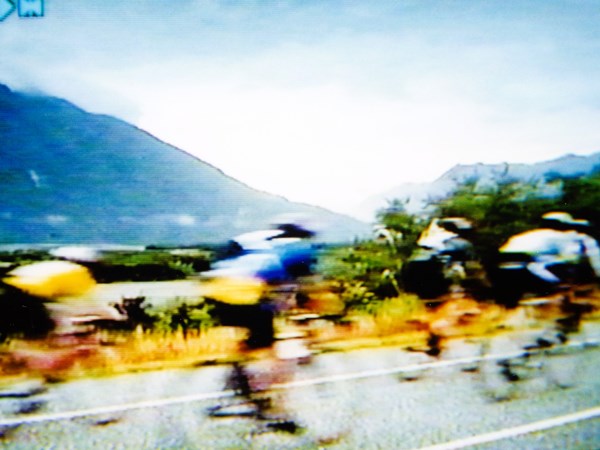
After about 20 kms of riding largely by ourselves, a bunch of about 15 to 20 riders caught up with Jerry and me. We stayed with it for the rest of the way. I had never ridden in a real peloton before, but Angus Wood and Rachel Beattie were good teachers, and I neither caused trouble nor got into any. I was pulled along by the force of the bunch far faster and far more easily than I had ever imagined, and when I reached the transition area shortly after 9:20 am, I was on a high.
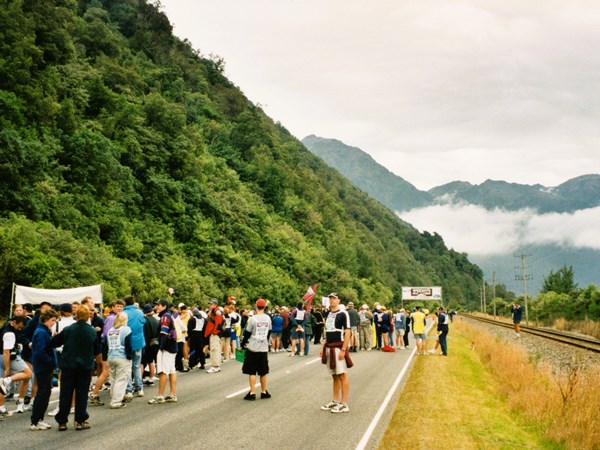
Above: Assistants in the February 2000 two-day Coast to Coast race waiting for cyclists to arrive at the transition
area at the end of the first cycling section of the race and the start of the mountain run. Below: Annette lacing up her running shoes while Pete gets her gear ready; and Nigel putting vaseline on his toes to prevent chaffing during the mountain run.
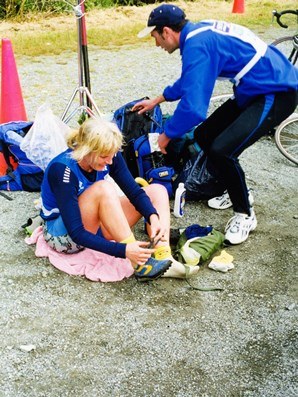 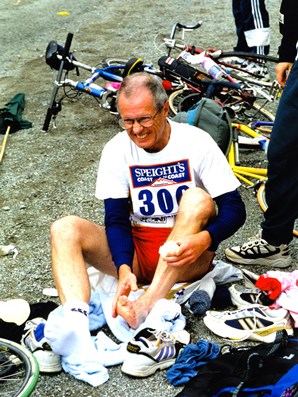
Before I’d left Wellington, Heather had sent me an email from Vietnam to wish me the “very best of luck for the challenge.” She added, “I hope that all goes well, and that the bits that you can control are all as good as you have trained for, and the bits you can't control operate in your favour and don't hinder you.” Heather’s message ended by saying “at very least I hope that there are parts that you actually enjoy (not just the end!).” I was thrilled to realise that in the first few hours of the race I had already got a great deal of enjoyment out of it – so much so that I wanted to tell Kate, Evan, and Pete all about it and I dawdled through the transition process of getting out of my cycling clothes and into my running gear. “Stop talking and hurry up”, urged Evan and Pete in particular. Eventually, just after 9:30 am, I left the transition area and ran through the control tent on the banks of the Otira river. The second section of the Coast to Coast had begun.
• The mountain run
The race immediately became a far tougher proposition. Jerry Rickman’s elder son, Simon, had told me that his father was waiting for me in the chute on the far side of the control tent. When I got there, however, there was no sign of him. I couldn’t see Jerry in either the Otira or the Deception river valleys, so I carried on down to the Otira river and began to cross it by myself. The river was swift, deep, and cold. As I started across, a helicopter hovered low overhead – adding to the mayhem and danger. I slipped into the river above my left shoulder, and was both frightened and relieved when I made it ashore.
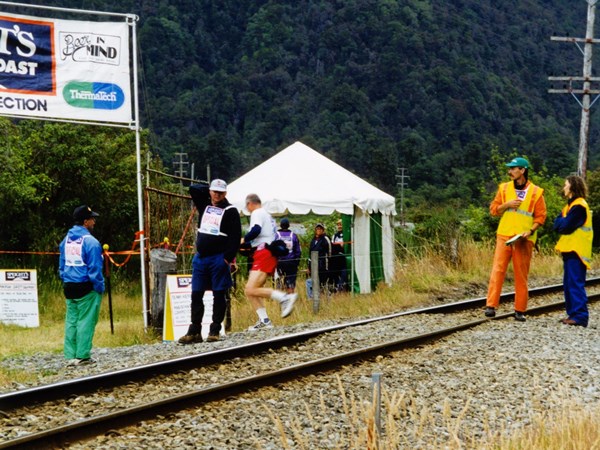
Above: Wearing red running shorts, I'm about to go through the control tent and start the mountain run on Friday morning, 4 February 2000. Below: A still from TV3's coverage of the race showing competitors making their way through the Otira river, which I described as "swift, deep, and cold."
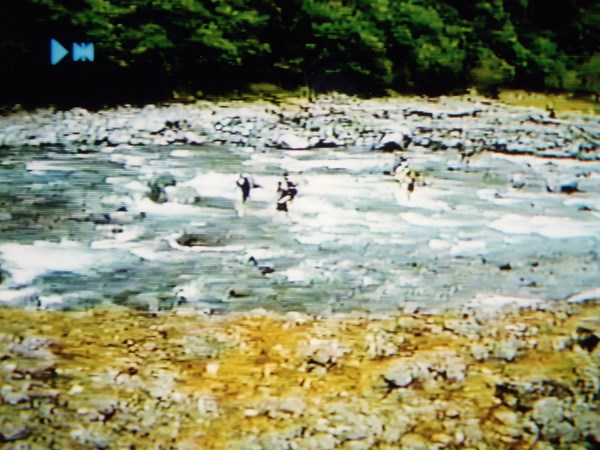
Ahead of me was a young woman and an older man. Maybe that’s Jerry, I thought. I’ll see if I can catch up with them. I did; it wasn’t Jerry; but the woman had done the race before (and thus knew the way) and was running at a pace I found very comfortable. I introduced myself to her (she was Sharon Vernel from Belfast, a town just north of Christchurch) and asked if I could tag along with her. Sharon (number 588, part of a team doing the race) was happy for me to do so, and about fifteen minutes later, we caught up with her husband, Ian, who – like me – was doing the two-day race as an individual. Sharon, Ian, and I then ran together for the next two-and-a-half hours or so, weaving our way up the river valley (usually running on the shore, but frequently clambering through the river) until Sharon and I gradually began to pull away from Ian as the Deception valley got steeper and steeper as we approached the main divide.
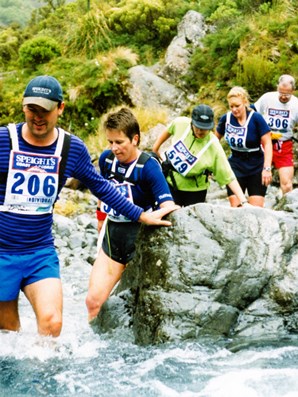 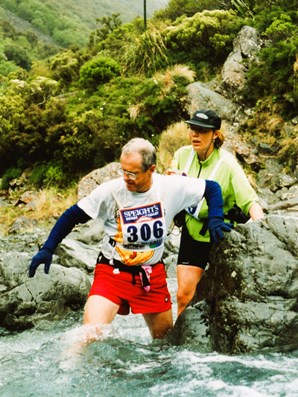
Photographs of Sharon Vernell (number 588) and me (306) crossing the Deception river and passing competitor 579 while doing so.
As we climbed higher, the weather got bleaker and colder. After three-and-a-quarter hours we reached the Goat Pass hut, just below the pass itself and the main divide. Persistent drizzle had set in, and I told Sharon I was going to stop at the hut to put on a warm, dry polypropylene top and wind-proof jacket. Not surprisingly, Sharon – who was, as she put it, “on a mission” to improve on the time she had taken to do the run the previous year – chose not to stop, and I didn’t see her again until Klondyke Corner. At the hut, I also ate some food for the first time since leaving the transition area and had an extra cup of water, and then I climbed the final hundred metres or so to Goat Pass, which is slightly over a thousand metres (3,280 feet) above sea-level.
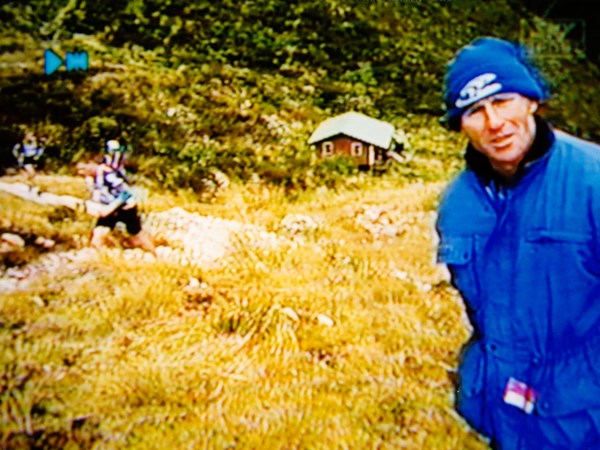
A still from TV3's coverage of the two-day race showing the Goat Pass hut.
Unfortunately, the race wasn’t downhill all the way from then on. There was an agonising climb up Dudley’s Knob (with photographers ensconced at the top waiting to capture my moment of pain as I reached the crest), and there were boggy beech forest tracks to be negotiated.
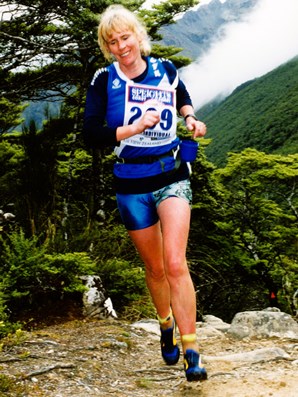 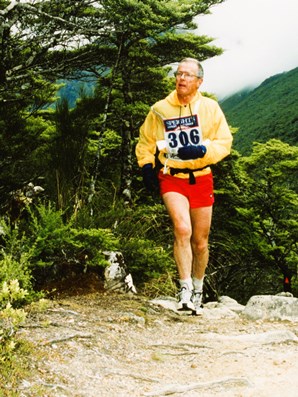
Above: Both Annette and I were photographed as we
reached the top of Dudley's Knob. Below: Annette and I were also photographed crossing rivers.
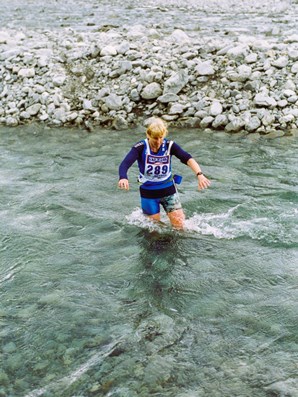 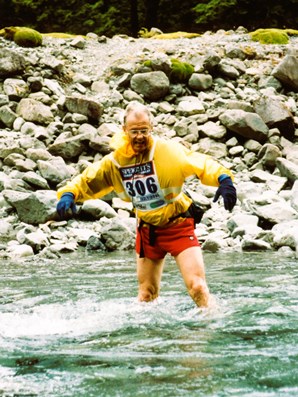
There were more river crossings – the Mingha and the Bealey several times apiece. Worse still were the boulders in the Bealey riverbed that made the last half hour of the run especially excruciating. However, running with two women – first, with Angela Burnett, a physical education teacher from Invercargill; and then for the final half hour with Sarah-Jane Weir, a lawyer from Dunedin – made the final two hours or so an instance of a burden shared is a burden shed (particularly in the case of the river crossings Sarah-Jane and I did together).
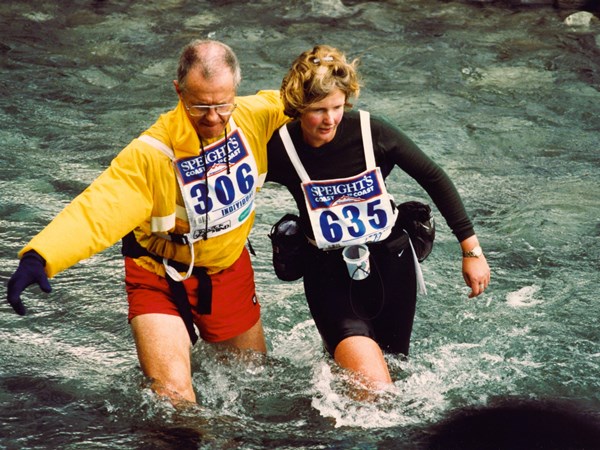
Above: Sarah-Jane Weir and I helped each other during the final few river crossings of the mountain run. Below: We then ran together in the finishing chute.
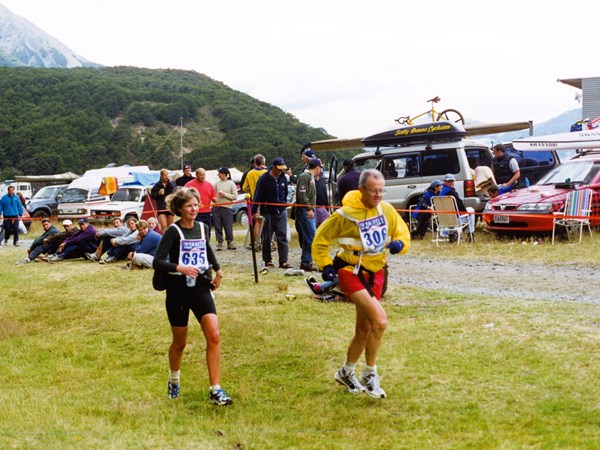
When I reached Klondyke Corner at about 3:20 pm, I had been on the go for just over 8 hours and 20 minutes, and the mountain run had taken me exactly 5 hours and 46 minutes.
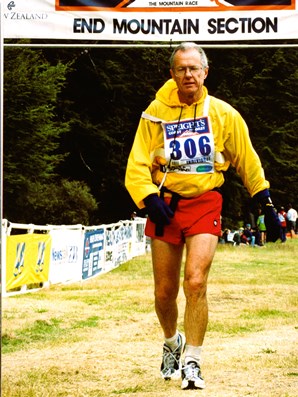 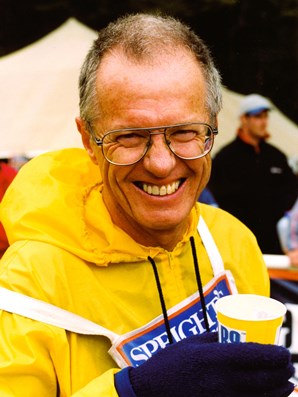
After 5 hours and 46 minutes of running, walking, and wading, I was delighted to finish the mountain section of the February 2000 two-day Coast to Coast race, and also to be able to refuel after it.
In terms of time, it was – by far – the longest run of my life. Although it didn’t feel like it at the time, the run proved to be my strongest suit. In the course of the 26 km run, I passed roughly 30 two-day individual competitors and about 20 two-day team members. I even managed to better Annette’s time for the run (it took her just over 5 hours and 57 minutes) – but, not surprisingly, she beat me handily in every other section of the race. Although both Kees Wesselink and Jerry Rickman, in particular, powered ahead of me on Day Two of the Coast to Coast, my margin over them on the run was so great that I came in ahead of both of them in the race as a whole.
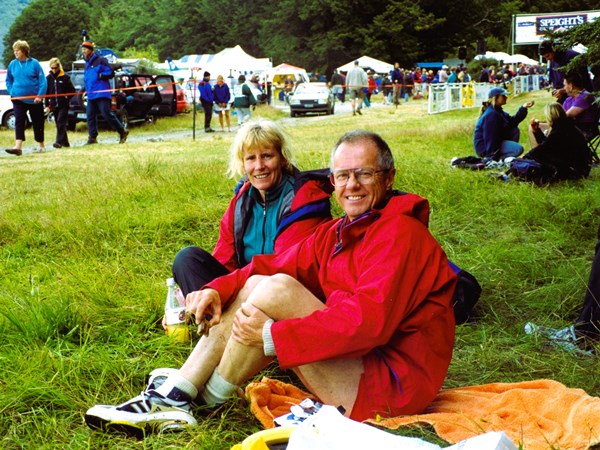
Above: With Annette after the mountain run. Below: With David Southall (left) and Jerry Rickman (right) after the mountain run (and, no, we didn't need assistance from the First Aid and Ambulance trucks behind us).
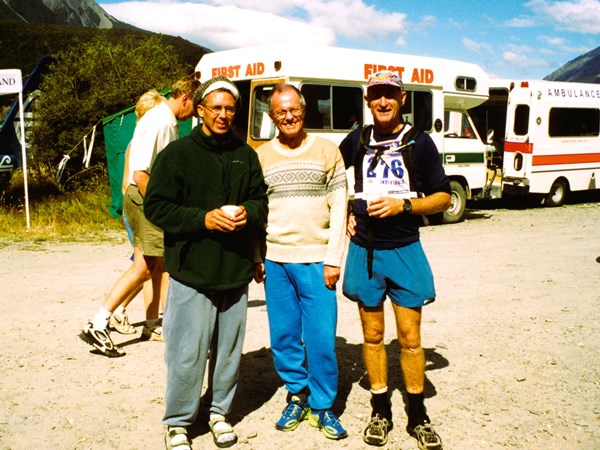
At the end of the run, I was also remarkably chipper. I sat around in the sun (how nice to see the sun at last) at the finish line with Evan, Kate, Annette, and Pete, enjoying some food and even a latté, cheering other competitors as they finished the run.
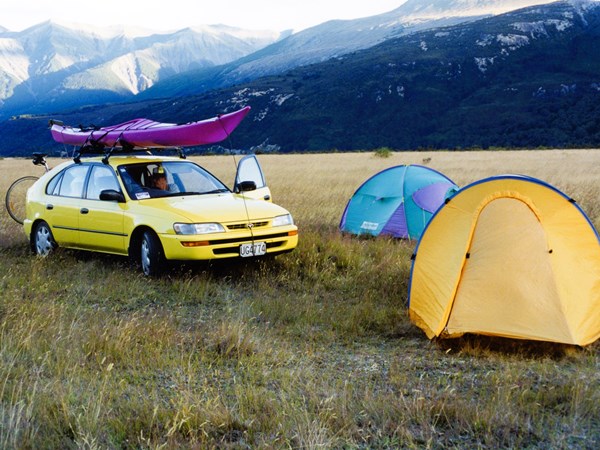
Above: UG4774, Kate's tent, and Evan's and my tent at Klondyke Corner. Below: Annette and Pete at Klondyke Corner; Friday afternoon, 4 February 2000.
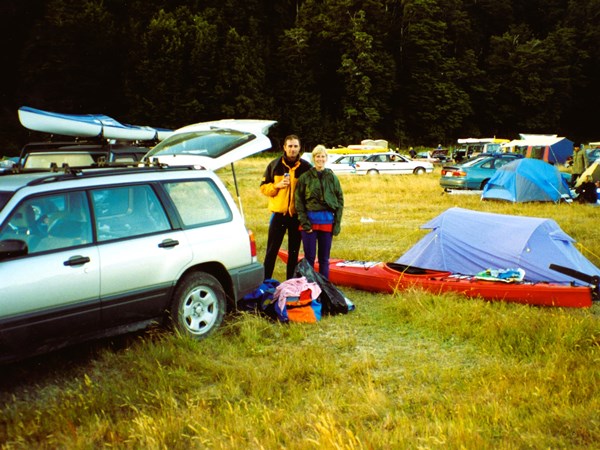
At about five o’clock the five of us wandered across the road to the main Klondyke Corner campsite. It was in an aptly named location, because – as had occurred in the Klondyke during the gold rush – an instant tent city had sprung up containing hundreds of tents and well over a thousand people. (If only 500 of the nearly 700 two-day competitors were there – after all, some lucky [spoilt?] people spent the night in holiday cottages – and if each competitor was accompanied by an average of two assistants, then there would have been 1,500 people at Klondyke Corner that evening.) We tidied up and at 6:00 pm drove 7 kms or so to Arthur's Pass, where we’d booked to have a meal at the Chalet restaurant. For dinner, at least, we too joined the ranks of the lucky [spoilt?] people. After a long and leisurely meal, which was both $9 cheaper and far more enjoyable than the meal we’d had the previous evening in Kumara, we drove back to Klondyke Corner, where we sorted out our gear and got ready for Day Two of the race. For the second successive day, we were asleep by about 10:00 pm.
DAY TWO OF THE RACE
For the second successive day, we were awake by 4:30 am. I got dressed, then sat in the tent and had breakfast, while Evan, Kate, and Pete packed up and prepared to leave the campsite. The life of an assistant on the Coast to Coast is not an easy one. The race rules stated very firmly that “all assistants must have left Klondyke Corner by 5:30. Do not be the last.” Pete, Kate, and Evan weren’t – they left in pitch darkness at 5:20 am and joined the long line of cars inching their way east along State Highway 73 to the Waimakariri river and the Mt White bridge. As the race was only scheduled to start again at 7:30 am, that left Annette and me with a lot of time to go to the loo (for the umpteenth nervous occasion), to wheel our bikes across to the start-line, to have an early-morning latté, and to chat with some of the other competitors. In fact, the time passed remarkably quickly, and before long we were lining up in groups of ten getting ready for the staggered start.
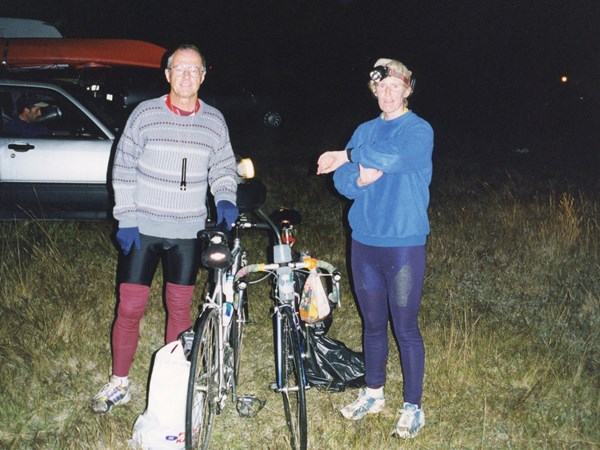
Before Evan and Kate left Klondyke
Corner at 5:20 am on Saturday, 5 February 2000, Evan took this photograph of Annette and me at the beginning of our two-and-a-quarter hour wait for the start of the second day's racing.
• The third section of the race: cycling and kayaking
At 7:30 am, the first group of ten cyclists (competitors 201 to 210 – the latter was Rachel Beattie) was sent on its way. A minute later, the next group of ten left, and so on. As a result, Annette (competitor number 289) started her ride just before 7:40 am, while I was in a group that set off two minutes later. I was by far and away the slowest cyclist in my group, and right from the start I was on my own. A couple of cyclists from the next group to start caught up with and passed me fairly early on in the ride, but it was a while before the rest of that group (and even longer before people from the group after that) overtook me. Not to worry; I wasn’t trying to bust a gut (even so, I managed to catch up with and overtake someone from the group in front of me), and I covered the 15 kms from Klondyke Corner to the Mt White turnoff in little over half an hour. I left my bike at the top of the hill and ran down the road, over the railway line, and across the bridge, where Evan met me and led me to my kayak. He and Kate helped me change out of my cycling shirt and into a polypropylene top and t-shirt (it was too warm and still to need to wear my windproof kayaking jacket), as well as to put my spray-skirt, lifejacket, cap and helmet on, and – after effecting a more urgent transition than I had the previous morning – I got into my kayak. Kate kindly stood in the river straddling the kayak, holding it still, while I secured my spray-skirt to the deck and prepared to start the kayaking section of the race.
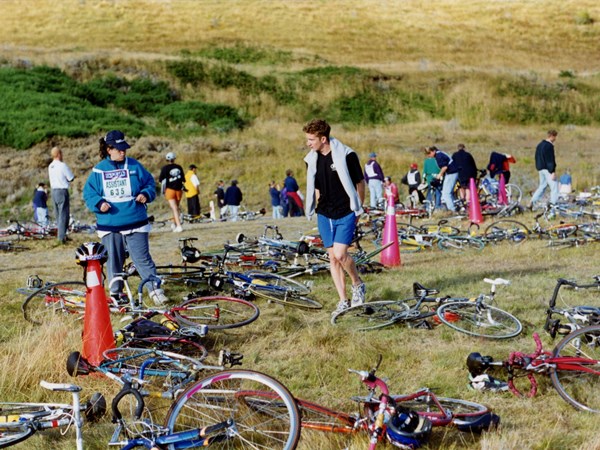
Above: Assistants searching for their competitors' bikes at the Mt. White turnoff. Below: Running towards my kayak; and getting ready to start the 67 kilometre paddle down the Waimakariri river.
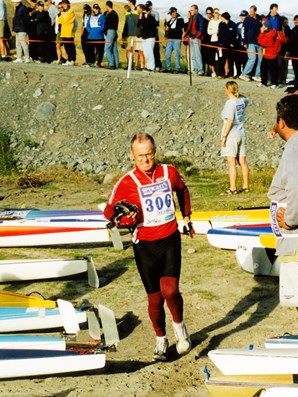 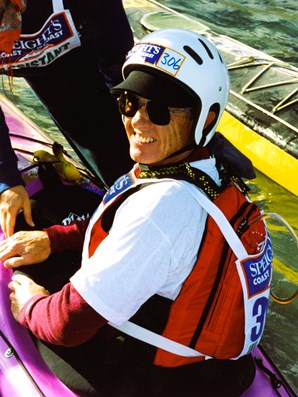
At about 8:30 am, I set off on the longest paddle of my life. At first, all went well. Although the Waimakariri had more water in it than usual, the braided sections of the river did not seem especially full. My rudder and the bottom of the boat scraped the rocks on the bottom of the river with monotonous regularity. Annette had had a bad start to the kayaking section: she’d accidentally set off not wearing her bib containing her competitor’s number and she’d been stopped and turned back to get it (or face disqualification). As a result, she’d restarted the kayaking section of the race only a few minutes before me, and it wasn’t long before I passed her grounded on a small rocky beach. I paddled on triumphantly, but about half an hour later got caught in the middle of choppy waves caused by the convergence of two rapidly flowing sections of the river. In an instant, I was flipped over and out of my kayak. Keeping tight hold of both my boat and my paddle, I was able to swim over to the left-hand bank of the river, haul my kayak ashore, and tip all the water out of the cockpit. While I was doing this, Annette paddled past me. I cursed, but soon caught up with her and passed her again. My Penguin was a faster boat than the sea-kayak Annette had hired, and I had a clear advantage over her in this respect. What is more, I didn’t have any further trouble navigating the first 25 kms or so of the river.
After two hours’ paddling, however, I reached the start of the Waimakariri Gorge. For the next 30 kms or so, the river is channeled into one fast-flowing stream which, to quote from Robin Judkins’ race notes, “is variously rated as a grade 2 and 3 stretch of water.” The kayaking immediately became a much tougher affair.
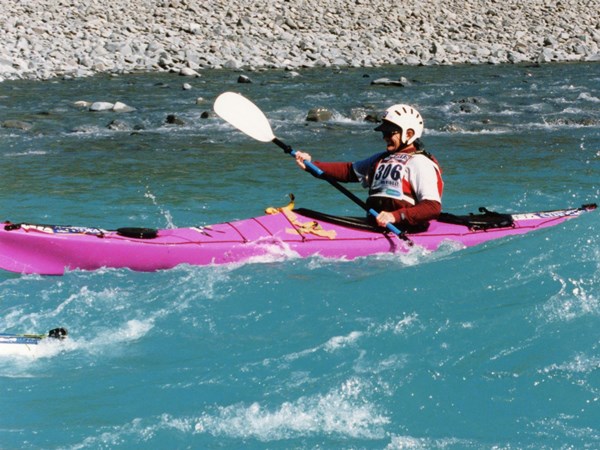
Two photographs of me kayaking down the Waimakariri river.
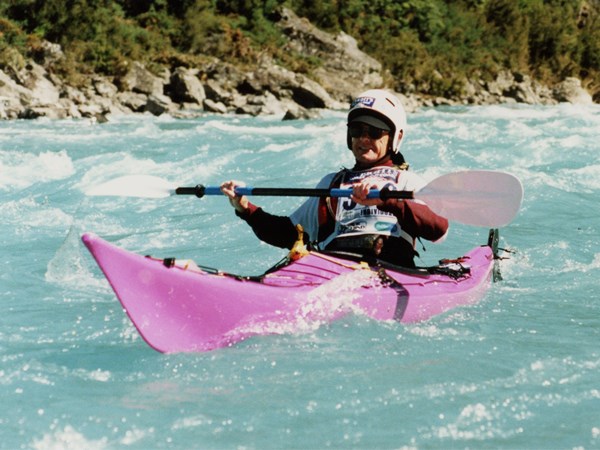
I successfully navigated the first sharp right-hand bend in the gorge, but immediately watched in horror as I saw kayak after kayak overturn at the next bend – a furious, fast-flowing turn to the left. There was no quiet water at the edges of the river; in kayaking parlance, there was no “chicken route.” The corner was a churning maelstrom, and – along with what I estimate was at least a third of the boats tackling it – I was soon tossed upside down and out of my boat. Luckily, reaching the right-hand bank proved surprisingly easy. “Christ, this is carnage corner,” yelled another unlucky paddler. He was right. While I was tipping the water out of my kayak, I counted eight or nine kayaks on the shore and only two upright in the river.
I got back into my kayak, safely navigated my way through the rest of the bend, and – considerably chastened and far more cautious than before – continued on my way. I took every chicken route I could find. I held my paddle so tightly that about three-quarters the way through the gorge three of my fingers (one on my left hand and two on my right) cramped closed and I had to prize them open – and then flex them back and forth – with my remaining movable fingers.
When I had been down the Waimakariri river on 3 January, I had got caught in a fierce eddy at a notorious corner in the gorge and then, trying to escape from it, had come out of my kayak. Many kayakers know it simply as “the spot just before the iron bridge.” For more than a month I had dreaded encountering that corner again – aware, too, of the fact that I wouldn’t have an instructor to help me get back into my kayak if I came out at the same place on race day. I came round a corner and there was the iron bridge. My heart sank, even though the sight of the iron bridge (a railway bridge parallel with the river, not across it) also meant that the end of the gorge was less than an hour’s paddling away. I approached the corner gingerly, looking for the safest route (the “chickenest route”) that would enable me to avoid the rock face, the waves, and the eddies.
“Yee Ha!” I let out a scream of delight when I got safely past the spot I had thought of on a daily basis for nearly five weeks as “nemesis corner.” It was a cry of triumph half an hour too soon. At what was probably the last fast right-hand bend in the gorge, I saw a woman in the kayak in front of me move carefully across towards the right-hand edge of the river in an attempt to take the chicken route past the corner. Her tactic didn’t work. She got caught in an eddy and was swung out sideways into the shallows on the inside corner of the bend. The chicken route I had wanted to take was well and truly blocked. What is more, there was nothing I could do about it: I was already in a fast-flowing stream of water heading straight for the large waves crashing off the rock wall at the head of the bend. I knew I was in trouble (thanks, I still think, to the woman in front of me). Like a cork on a wave, I was thrown up in the air, tossed upside down, and then carried downstream by the force of the current for a hundred metres or more before I finally struggled ashore on the left bank of the river. I had a pee, and began the task of tipping the water out of my boat. At that moment, Annette paddled past me. “Hi Annette,” I called, and then told her in no uncertain terms what I thought of the river. It was language that would have made a sailor blush – and possibly even some kayakers too ... It may have had an effect on Annette for all I know, because I didn’t see her again until I got to Sumner beach.
Four-and-a-half hours after leaving the Mt White bridge, I reached Woodstock, the end of the Waimakariri Gorge. Now all I had to do was paddle for another hour or so through about 12 kms of a flat, braided river system. Did I say “all”? It was hot and tiring. The braids in the river – the different streams into which the Waimakariri breaks – were shallow and slow. It was hard going, so much so that I even sought out the fastest routes (the “non-chicken routes”) whenever possible. Despite this, about twenty minutes from the end I found myself beached in the shallows, high and dry. Oh well, I consoled myself, I needed another pee anyway and got out of my boat to have one before relaunching it in deeper water.
Shortly before I was beached, I had passed competitor number 304. By definition (well, by number anyway), he was in the group of ten people I had set off with from Klondyke Corner on our 15 km bike ride roughly six hours earlier. At least I was ahead one of my direct “rivals”, so I called out cheerily, “Hello, 304!” While I was beached, he passed me and called out “Hello, 306!” I soon caught up with him, passed him, and again shouted, “Hello, 304!” We paddled on to the end of the kayaking section in single file – both managing to take the chicken route safely round the final bend in the river and avoid doing what dozens of people do each year: tip out in full view of all the assistants, supporters, and spectators at the end of the kayaking section of the race. After slightly more than five-and-a-half hours on the river, I paddled under the Gorge bridge on the Springfield to Oxford road and beached my kayak on the right-hand bank of the Waimakariri river. The third section of the race – the one I had feared the most – was over. Three minutes later, number 304 finished the kayaking section as well.
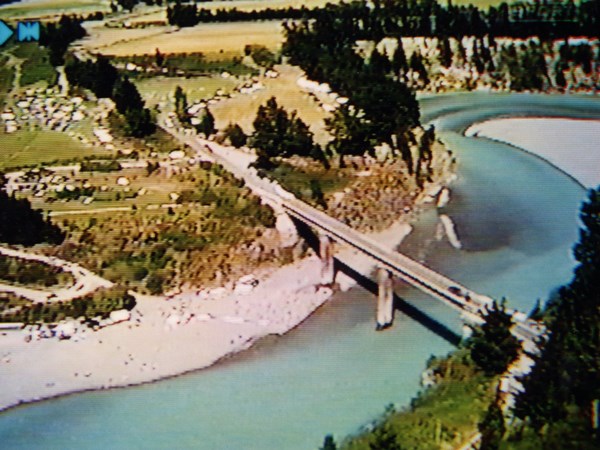
Above: A still from TV3's coverage of the race showing the Gorge bridge across the Waimakariri river and the end of the 67 kilometre kayaking section of the Coast to Coast race. Below: Feigning (?) exhaustion at the end of the kayaking section of the race; and being helped out of my kayak.
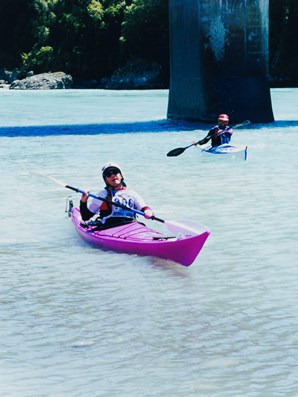 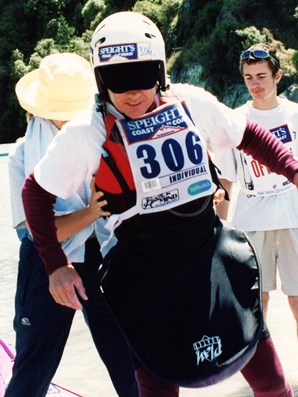
I ran through the control tent and up the hill to the bike stands, where Evan, Kate, and Pete helped me change into my biking clothes. It was a hot, blustery afternoon, and Evan and Pete made me drink as much water as possible. I’ve had plenty, I said. No you haven’t, they replied, and forced me to drink more. Kate slapped sun-block cream onto me, and then I wheeled my bike across the paddock to the road to start the ride.
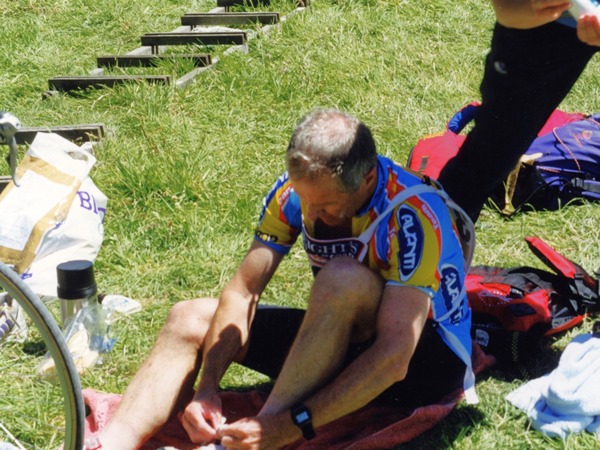
Above: A photograph of me during the kayaking-to-cycling transition on Day Two of the race. Below: At the start of the 70 kilometre ride to Sumner and the Pacific Ocean.
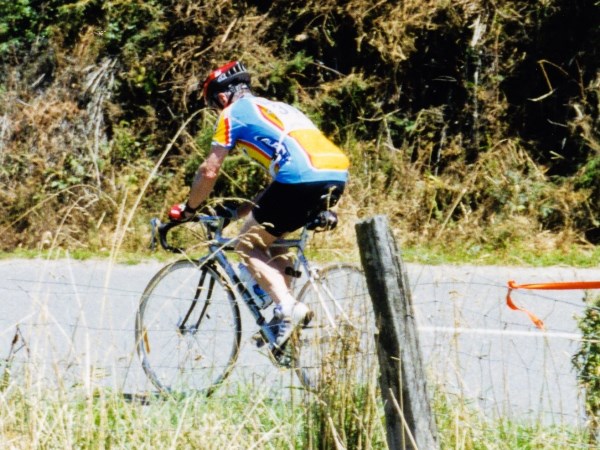
• The fourth section of the race: the final ride
After a short (and not too painful) climb out of the Waimakariri valley, the 70 km-long final bike ride to Christchurch and the Pacific coast is on roads that make Holland look hilly. The ride would have been a cinch but for the fact that there was a strong north-easterly wind – and I was heading east.
At the start of the ride, I made a quick mental calculation (no – that’s not true, as a result of my tired state, it was a slow and tortuous mental calculation) and I worked out that if I could average roughly 25 kms per hour over the entire distance, then I should be able to complete the race as a whole in less than 18 hours. That became my aim, and I battled determinedly into the head wind. It was hard, painful work. As long as I was riding past farms and other properties along the Old West Coast Road that had poplar, pine or macrocarpa shelter belts, I was able to average about 29 kms per hour. As soon as I lost the protection of the trees, my speed dropped by seven or eight kilometres per hour – despite the same amount of (or even greater) effort on my part. My progress wasn’t helped by the water Evan and Pete had forced me to drink at the transition – in the first hour or so of the ride, I had to stop for a pee three times ...
I pedalled and cursed my way east. Then, what seemed unexpectedly early on in the ride (although in reality it was probably an hour and a half or so after I’d started the ride), I came to Bell’s Road. My heart soared: a fortnight earlier, Bell’s Road had been my turn-around point on my ride along the Old West Coast Road on Donal Hockey’s mountain bike. Although it wasn’t exactly home ground, the route now felt like familiar territory. I reached the junction of the Old West Coast Road and Highway 73 and turned left towards the outer suburbs of Christchurch. A short while later I was heading down Yaldhurst Road and passed the turnoff to the Hockeys’ house. This was progress. I turned right into Peer Street and for the first time for about 55 kms I had company on the ride. A man from Invercargill caught up with me. We rode up and over the flyover across Blenheim Road and down towards the Southern Motorway together. We carried on through the suburbs of Addington and Sydenham.
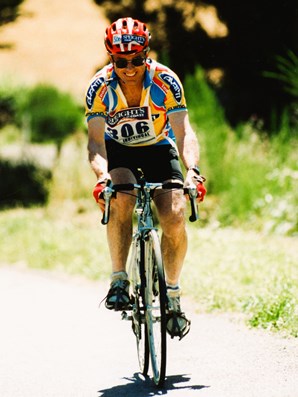 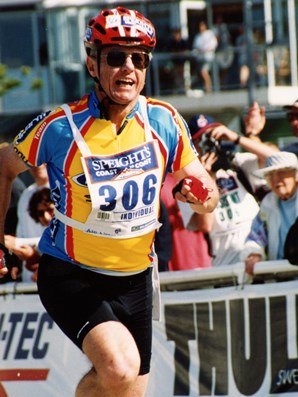
Photographs of me on the final bike ride and on my
sprint to the finish line.
Then, while waiting at a traffic light in Opawa, I heard a familiar voice, “Hello 306; this is 304!” A small bunch of four or five riders had caught up with us. I was keen to try to stay with the bunch and when the lights turned green, I pressed down hard on my pedals. I slipped, my right foot came out of its toe-clips, and I almost ended up face-first on the pavement. By the time I’d recovered, the bunch had taken off, and – try as I did – there was no way I could catch it. Once again, I was riding by myself. I pressed on, though, still determined to break 18 hours. Before I’d reached Ferry Road, I had caught up with the first person to be dropped from the back of the bunch. Then crossing the causeway between Mt Pleasant and Redcliffs, I passed another rider. Finally, on the eastern side of Redcliffs, I overtook number 304. Revenge was sweet. Spurred on by my small victory, I pedalled furiously for the last kilometre or so into Sumner, lifting my speed to about 35 kms per hour. I sped into the grass chute before the beach, just failing to catch the cyclist in front of me, dropped my bicycle, and sprinted down the beach to the finish line. Robin Judkins greeted me – as he did every competitor who finished – with a handshake and a can of Speight’s beer.
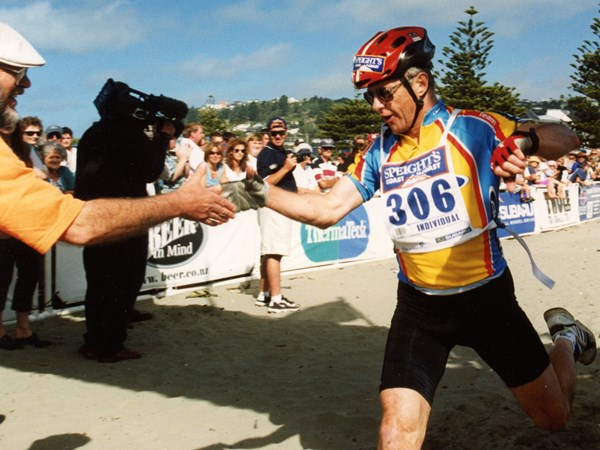
Being congratulated at the finish line by race organiser, Robin Judkins.
The final bike ride had taken me just under 2 hours and 50 minutes, and I had completed the Coast to Coast in 17 hours, 49 minutes, and 32 seconds. I was ecstatic. I had achieved my three aims – I had finished; I had not come last; and I had broken the 20-hour deadline I’d set for myself by more than two hours.
AFTERMATH
Evan and Kate, Annette and Pete, and Burn and Margaret were at the finish line when I got there at about 5:10 pm. It was wonderful to see them all, and I chatted excitedly with them. I met number 304’s father, and later – on the way back to Burn and Margaret’s car – spoke to 304 as well. Two days later I found out that number 304 was Iain Cossar, a close friend of Pat Moloney’s, a colleague at Victoria University who had an office next to mine. I also saw Rachel Beattie at the finish line – she’d broken 16 hours, but was a bit disappointed that she had not broken fifteen-and-a-half hours, which was Robin Judkins’ required standard for people wanting to do the one-day race. Sharon and Ian Vernel were at Sumner too, and it was great to be able to talk to them in more relaxed circumstances than had prevailed the previous afternoon.
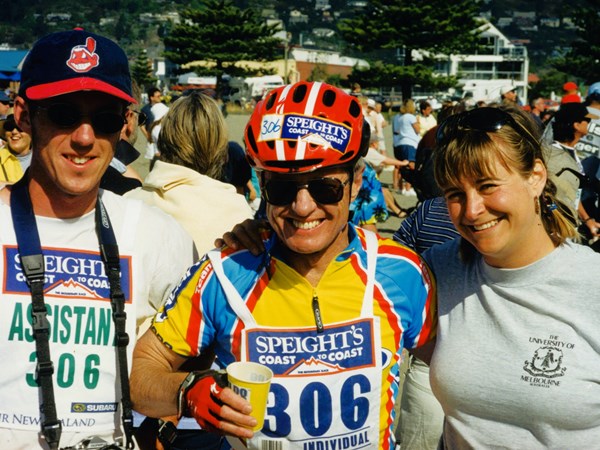
Above: Evan, Nigel, and Kate after the race. Below: Nigel and Annette after the race.
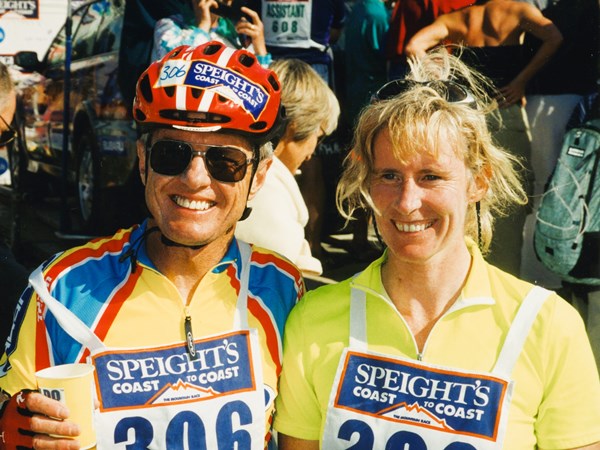
In an act of symbolic homage, I also wandered down to the water’s edge to look for a stone. As Burn had warned me, though, the biggest stones on Sumner beach are grains of sand, and a shell from the Pacific had to suffice instead.
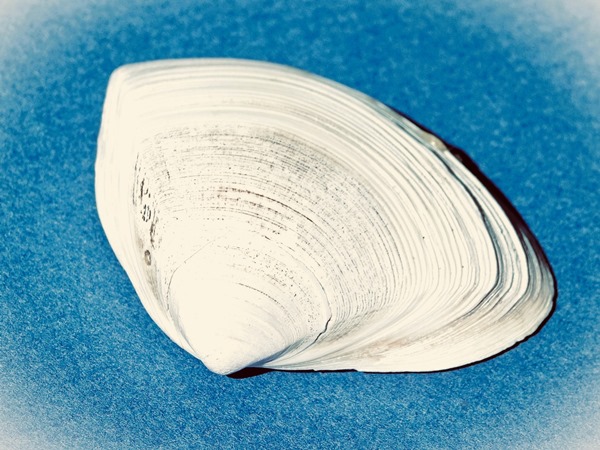
The shell I picked up on the shores of the Pacific.
We lingered at the finish line until Steve Gurney came in shortly before 6 o’clock. He won the one-day race – for the fourth successive time – in 11 hours and 47 minutes. At the prize-giving ceremony the following day, I learnt that the last one-day competitor to finish was 57-year-old Mike Ward. Mike was well known as a former Values Party and, later, Green Party candidate in parliamentary elections, as a Nelson city councillor, and as the only person in New Zealand to have taken part in all the first 18 Coast to Coast races. It was very humbling to learn that his time for the one-day race – the time that had gained him the one-day wooden spoon – was seventeen-and-a-half minutes quicker than the time it had taken me to do the two-day race.
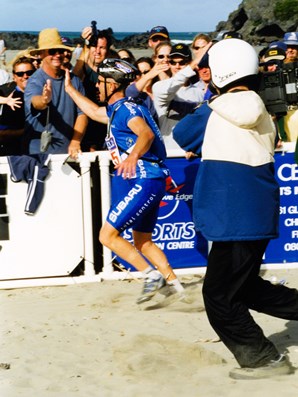 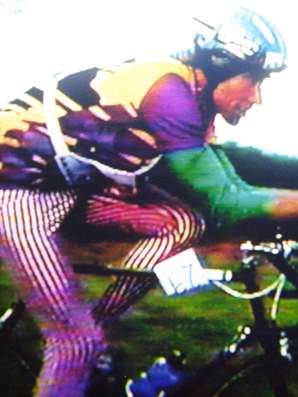
Left: Steve Gurney in the finishing chute. Right: A still from TV3's coverage of the race showing Mike Ward on his bicycle during the final ride to Sumner.
Kate, Evan, and I went back to the Hockeys; Annette and Pete went to a nearby motel. After dinner I got ready for bed, but Evan and Kate – mere youngsters that they were – decided to go out for a drink with Annette and Pete (a plan that was foiled, though, when they went to the wrong restaurant). The following morning (Sunday, 6 February), Kate, Evan and I went to the Christchurch town hall to pick up my pack of photographs that had been taken of competitors during the race, for the post-race lunch, and for the prize giving in the main auditorium. I was delighted to learn that two people, Jill Westenra and Penny Edwards, who belonged to the club that Evan and I ran for (namely, the Wellington Scottish Athletics Club), had come first and second respectively in the women’s section of the one-day race (with times of 13:16:25 and 13:39:23).
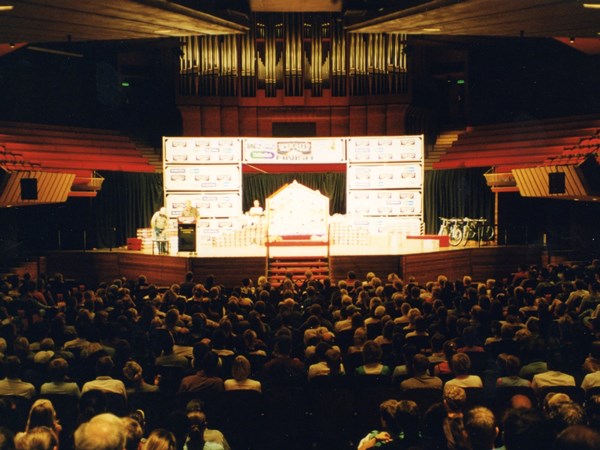
The February 2000 Coast to Coast prize-giving ceremony in the main auditorium of the Christchurch town hall.
Later in the afternoon, Evan and I went round to see Alan and Roberta Conway, then returned to the Hockeys in order to ring Heather at 6:00 pm, before heading off to visit David Novitz and Clare Simpson. After that, we met Annette, Pete, and Kate at the Dux de Lux restaurant for a final celebratory meal together – and a final group photograph.
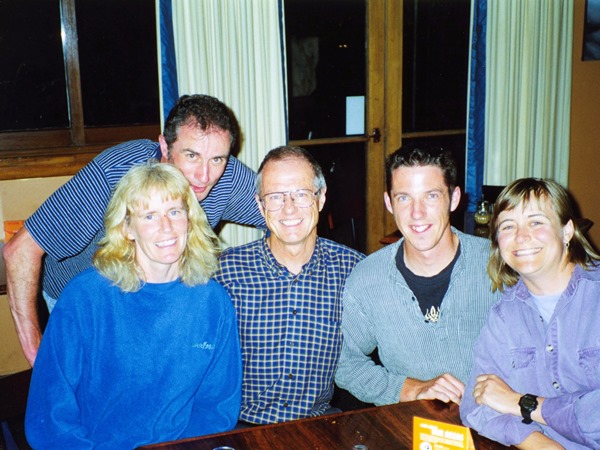
Our final group photograph, taken in the Dux de Lux on Sunday evening, 6 February 2000. From left to right: Annette, Pete, Nigel, Evan, and Kate.
On Monday, 7 February, Evan stayed in Christchurch to do some work, while Kate and I drove north to Picton. The journey was not without incident: a major car crash saw State Highway 1 closed, and to get round the crash site we had to do a roughly 50 km detour via Scargill, a spot I’d never heard of before. We then got stuck in a long line of slow-moving traffic. The final straw occurred just north of Ward: at some roadworks, a sandstone boulder rolled down the hill and crashed into and under our car and broke the plastic wheel-guard under the right-hand front fender. We got into Picton half an hour after we should have, but were still able to make the 4:00 pm fast ferry sailing.
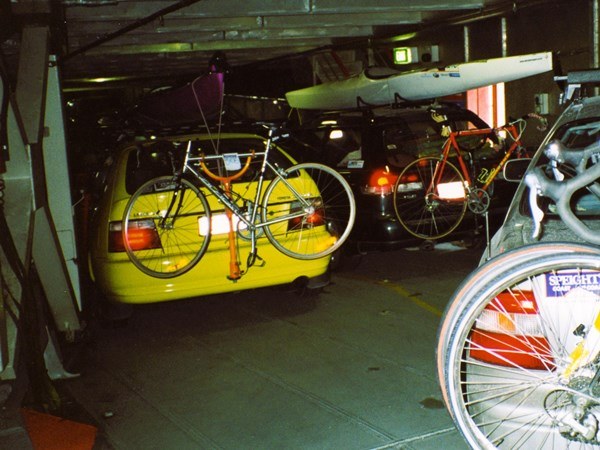
A fast ferry full of Coast to Coast cars, kayaks, and bikes.
Every second car on the Lynx had a kayak on top and a bike on the back – including Angus Wood’s and Jason Page’s. By 6:00 pm, though, we were back in Wellington. The world of the Coast to Coast was over, and the world of work was about to begin again.
EPILOGUE
For months, various questions had plagued me about the Coast to Coast? Had I done enough training? Could I cope with bunch riding? Would I have a puncture? Would I survive the kayaking section? Would I tip out again near the old iron bridge? Would I finish? This account of my experiences in the 2000 Coast to Coast answers all those (and many other) questions.
But there were still two more questions that needed to be answered. First, did I enjoy it? I can answer that by pointing out that despite the effort and the pain, not once during the two days of the Coast to Coast did I ever ask myself, “What am I doing here?” or regret my decision to do the race. Not surprisingly, the second question was, Would I do it again? The answer to that was unambiguously Yes. Having broken eighteen hours in the 2000 Coast to Coast, I decided I wanted to do it again in order to break the seventeen hours’ barrier ...
Unfortunately, however, that was never to be. I successfully applied to do the 2004 Coast to Coast, and I trained hard for it. On 10 January 2004, I flew to Christchurch and, as a part of my training schedule, the following day – accompanied by two guides and three other clients – I kayaked the entire 67 km of the Coast to Coast course from the Mt White bridge to the Gorge bridge on the Waimakariri river. However, during our lunch stop on the banks of the river, I stepped on a stone and injured the sole of my left foot. In an attempt to avoid putting pressure on it, I concentrated on cycling and kayaking for the next two-and-a-half weeks, but finally had to concede that the stress fracture I’d incurred meant I simply couldn’t run, and on 29 January 2004 I withdrew my entry for the race.
Of course I was sorry I couldn’t do the Coast to Coast again. Nevertheless, I’ll forever remain delighted that I successfully did the Coast to Coast once. It was – without a shadow of doubt – one of the greatest sporting events in which I ever participated. It was thoroughly challenging, highly rewarding, and extremely enjoyable.
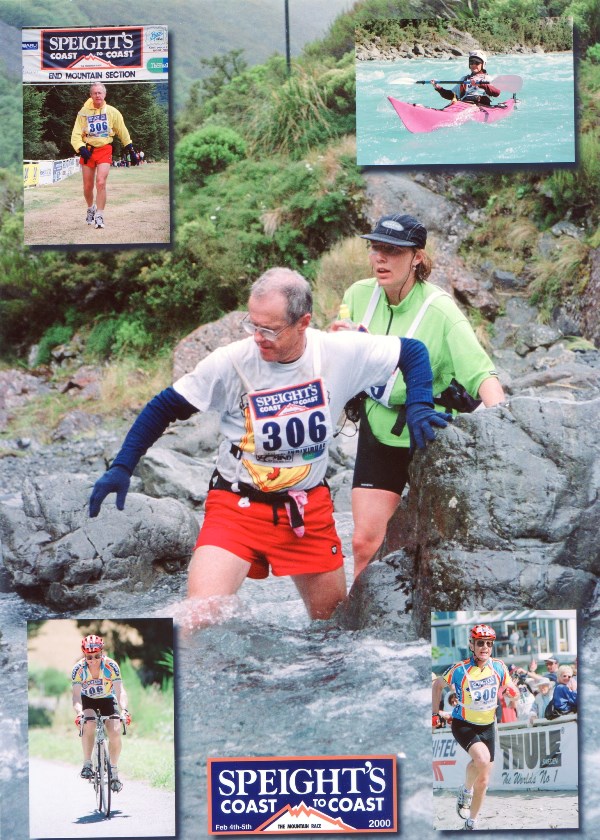
APPENDIX 1:
A detailed breakdown of my times for each section of the race
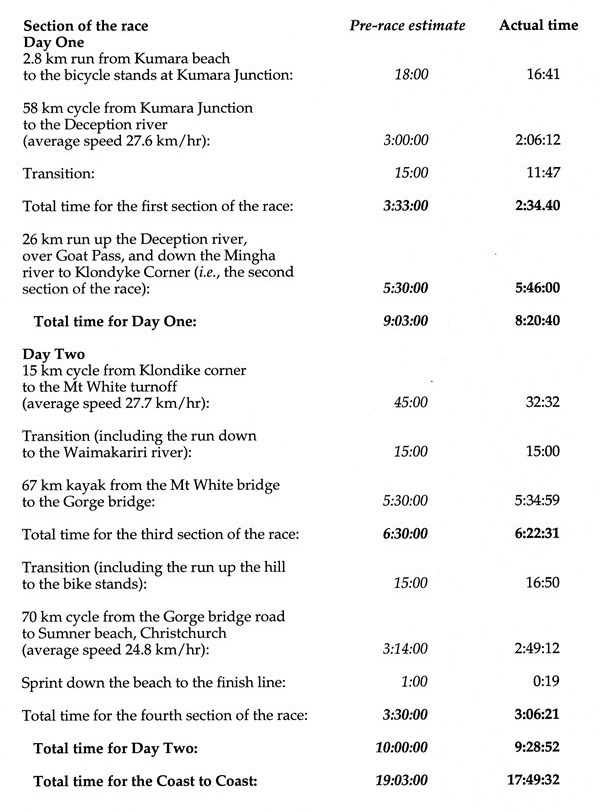
APPENDIX 2:
How each of the competitors mentioned in this account of the race fared
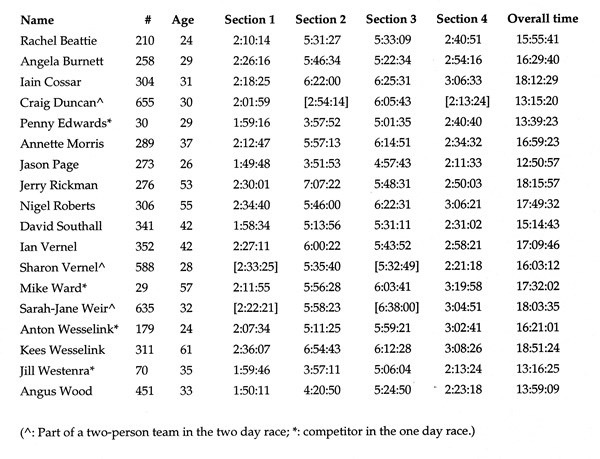
APPENDIX 3:
The Cost to Cost of the Coast to Coast
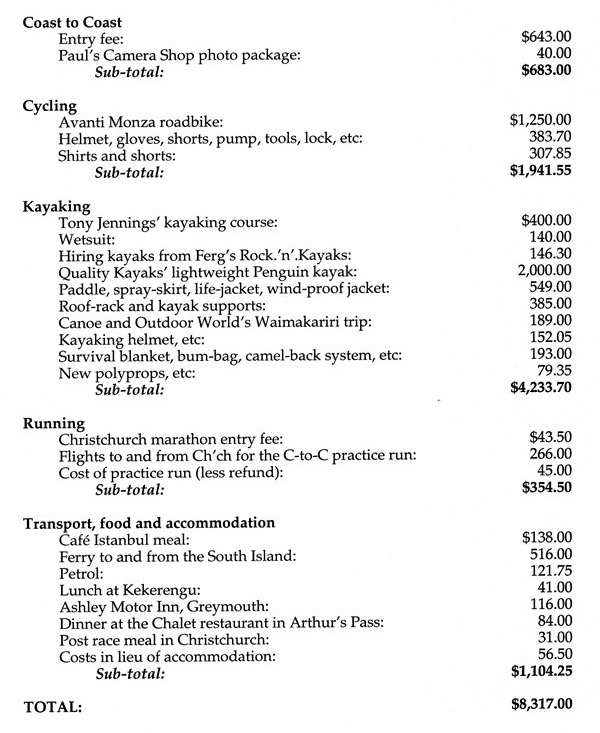
APPENDIX 4:
Further reading
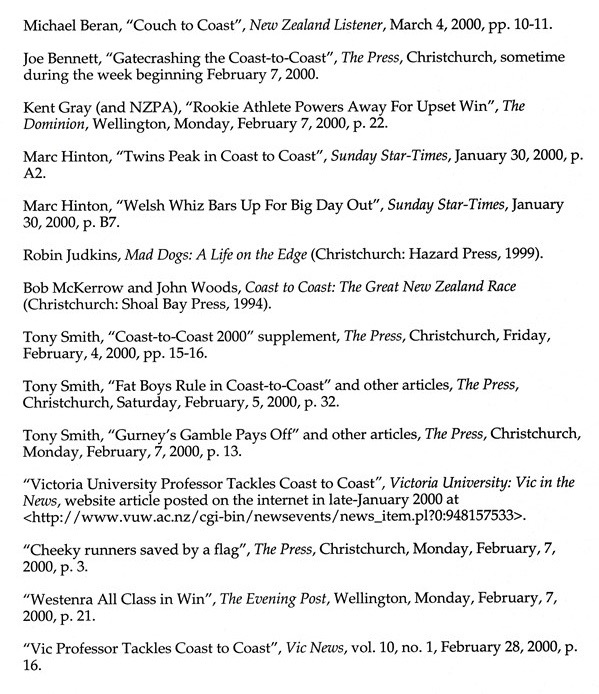
APPENDIX 5:
The Vic News article
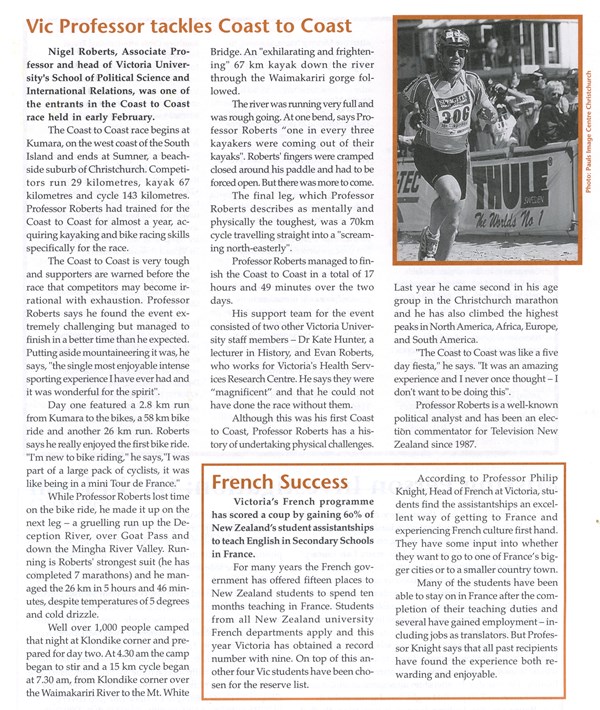
This is a slightly amended version of an account I wrote in February 2000 about my Coast to Coast experiences and which was originally produced as a 20-page booklet called "The Coast to Coast". This digital version was 'launched' on my website on 4 February 2025, a quarter of a century after I did the Coast to Coast. |